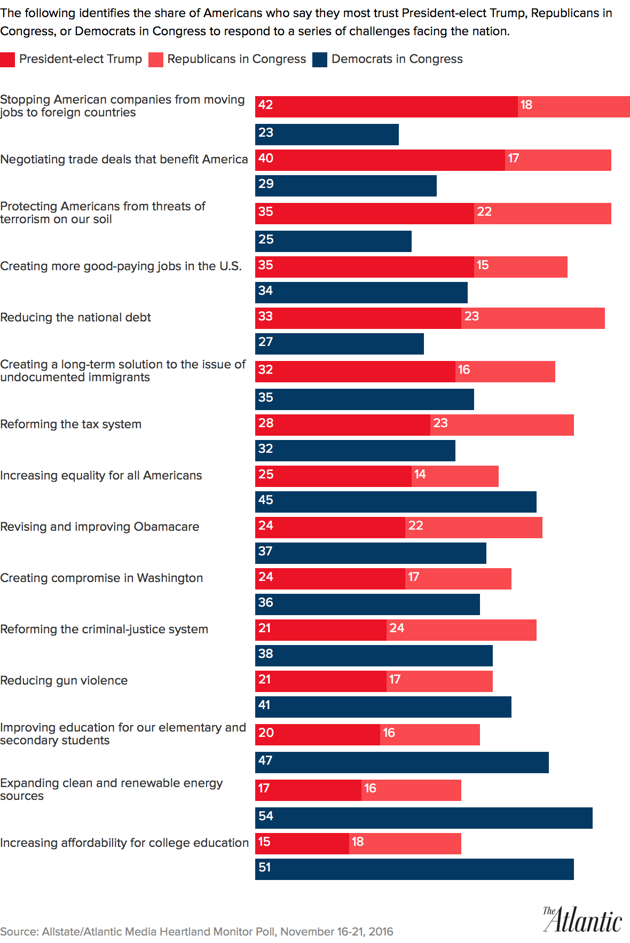Though last months election provided Trump and his fellow Republicans unified control of the White House, House of Representatives, and Senate for the first time since 2006, the latest Allstate/Atlantic Media Heartland Monitor Poll shows the country remains closely split on many of the key policy challenges facing the incoming administrationand sharply divided on whether they trust the next president to take the lead in responding to them.
In the past, its been where they get in office and then it seems to be like nothing seems to get accomplished, too much red tape or something, said Philip Denning, a mechanic in Houghton, Iowa, who voted for Trump and responded to the survey. And I believe that maybe Donald Trump will cut through that red tape and get people to come together.
But opinion splintered much more on who should take the lead role in driving the nations agenda; in fact, the results suggested that many Americans might prefer a kind of multipolar Washington, with three distinct orbits of power checking each other.
The newly elected president, strikingly, did not top the list when adults were asked who they trust more to develop solutions for the major challenges facing the country. A 35 percent plurality of those polled picked Democrats in Congress; Trump finished second at 26 percent. But when combined with the additional 20 percent who pointed to congressional Republicans, more adults looked toward the GOP than to Democrats. (The remaining 15 percent said they trusted none of the above.) Even among Trump voters, a relatively modest 53 percent said they most trusted him to develop solutions; about one-third picked congressional Republicans.
That "Increasing equality for all Americans"Splintered loyalties were also evident on a subsequent question that asked adults whether they most trusted Trump, congressional Republicans, or congressional Democrats to handle 15 specific issues. As the chart below shows, on no issue did a majority of adults point to Trump. He scored best on one of his signature themescreating jobswith 42 percent saying they most trusted him to stop American companies from moving jobs to foreign countries and 40 percent preferring him for negotiating trade deals that benefit America. In both cases, that far outpaced the share of adults who looked first to congressional Democratsor, for that matter, congressional Republicans.

Plenty more at the link.Paul Reedy, a white, self-employed construction contractor in North Chesterfield, Virginia, encapsulated the fervor of many Trump supporters for a harder line on immigration. I personally have lost jobs to illegal-immigrant crews because they come in for cheaper labor and cheaper wages and under-bid me, he said. I know one contractor [who] hired these guys and paid them under the table, and they would do all the drywall work. And so that knocked out a lot of the American crews, the drywall guys, and eventually they started even taking over the painting business. We just couldnt even compete with the lower prices they were paying them.
Tony Cassio, a Hispanic high-school teacher and Clinton supporter in McAllen, Texas, is as passionate on the other side. The immigration hard-liners, he says, are unfairly maligning people coming over to survive, and portraying them as dangerous when they are not. I remember during the election, Trump made a big deal [saying] Im going to Laredo, Texas, Cassio said. I mean, I go to Laredo once twice a year. Its not like Im going to a third-world war zone. I live on the border. I live in a town very similar to Laredo. They make it sound like Im dodging bullets and stuff every day. Its safe. I love living down here.
On several other issues, most adults endorsed positions usually identified with Democrats. By 60 percent to 36 percent, adults said they preferred revising and improving the Affordable Care Act to repealing and replacing it. While 57 percent of adults wanted to prioritize greater production of renewable fuels like wind and solar to address climate change, just 37 percent said Washington should stress increasing production of fossil fuels, like natural gas and oil, to increase American energy independence.
